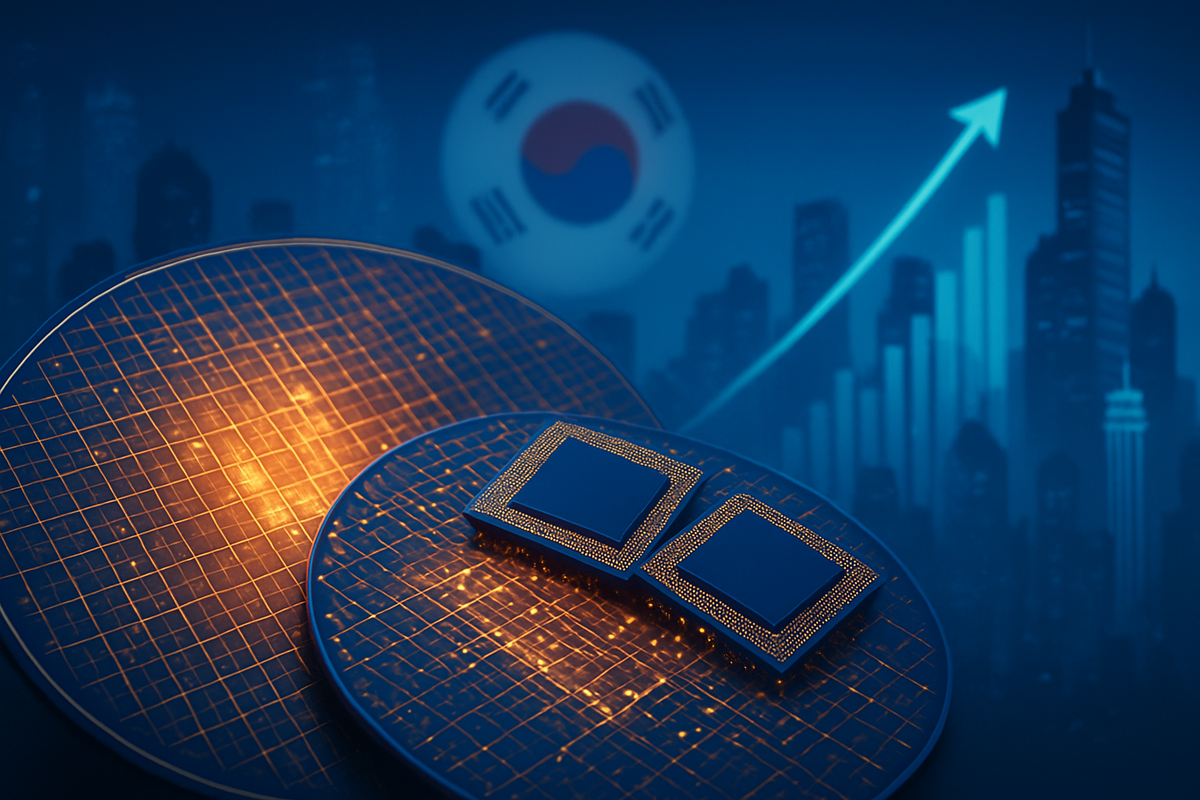
Seoul, South Korea – October 1, 2025 – South Korea's semiconductor exports soared to an unprecedented $16.61 billion in September 2025, marking a staggering 22% increase year-on-year. This record-breaking performance, now firmly in the past relative to the current date, not only solidified the nation's position as a global chip powerhouse but also served as a powerful testament to the enduring strength of the artificial intelligence (AI) boom. The surge in demand for high-end memory solutions, particularly those integral to generative AI chipsets, propelled overall exports to a new monthly high of $65.95 billion, signaling robust economic momentum amidst complex global trade dynamics.
This exceptional export data underscores the semiconductor sector's pivotal role as the primary engine of South Korea's export-driven economy. The figures, which exceeded market forecasts, indicate a significant recovery and expansion in the global technology market, with South Korean chipmakers at the forefront of innovation and supply.
A Deep Dive into the Record-Setting Performance
September 2025 witnessed South Korea's semiconductor exports reaching an all-time monthly high of $16.61 billion. This remarkable figure represents a 22% year-on-year increase and was the second consecutive month of such record-breaking performance. The driving force behind this surge was the robust global appetite for advanced memory chips, specifically Double Data Rate 5 (DDR5) and High Bandwidth Memory (HBM) products, which are critical components for powering cutting-edge generative AI chipsets. These specialized chips, coupled with higher fixed prices for memory, propelled the sector to account for over 25% of South Korea's total exports in September.
Overall, South Korea's exports in September reached an impressive $65.95 billion, reflecting a 12.7% increase from the previous year. This marked the fastest growth in 14 months and the largest monthly export volume since March 2022, extending a four-month streak of year-on-year growth. The third quarter of 2025 concluded with a new quarterly export record of $185.03 billion. While a favorable calendar effect, stemming from a shift in the Chuseok thanksgiving holidays that provided four additional working days in September 2025 compared to the previous year, average daily exports still ranked as the second-highest for any September on record.
The immediate market reaction to this news was overwhelmingly positive, with South Korean equities experiencing a rally, climbing as much as 1% in early Asia trade, prominently led by the nation's chip heavyweights. Furthermore, a separate survey indicated that South Korea's manufacturing sector expanded in September for the first time in eight months, bolstered by improving overseas demand. The nation also recorded a substantial trade surplus of $9.56 billion, the largest for September since 2018, further contributing to its financial stability. Despite these positive indicators, the Korean won experienced some depreciation against major currencies, highlighting the nuanced interplay of various economic factors. Diversification efforts in export markets also showed fruit, with significant increases in shipments to the European Union (up 19.3%), ASEAN bloc (up 17.8%), Central and South America (up 34%), the Middle East (up 17.5%), and India (up 17.5%). Exports to China also saw a slight increase of 0.5% after four consecutive monthly declines, while exports to the U.S. contracted by 1.4%, primarily due to declines in tariff-targeted items like automobiles, steel, and machinery.
Companies on the Rise: Samsung and SK Hynix Lead the Charge
South Korea's record semiconductor exports in September 2025 have delivered a significant boost to its two major chip manufacturers, Samsung Electronics (KRX: 005930) and SK Hynix (KRX: 000660). Both companies are critical players in the global production of high-bandwidth memory (HBM) and DDR5 chips, the very technologies driving this export surge.
SK Hynix (KRX: 000660) has particularly cemented its leading position in the HBM market, with reports from Q2 2025 indicating a market share of around 62% in HBM shipments. The company's pioneering efforts in HBM development since 2013 and its technological edge with HBM3 and HBM3E solutions have made it a primary supplier for major AI chipmakers like Nvidia (NASDAQ: NVDA). This strong demand for HBM has translated directly into robust financial performance, with SK Hynix (KRX: 000660) reporting substantial profit surges and outperforming competitors in early 2025. The company anticipates doubling its HBM shipments in 2025 and plans to significantly expand its HBM production capacity, strategically shifting its focus towards these high-value chips.
Samsung Electronics (KRX: 005930), while a dominant force in the overall DRAM market, has been aggressively working to regain ground in the HBM segment, where it has recently lagged behind SK Hynix (KRX: 000660) and Micron Technology (NASDAQ: MU). Despite facing some technical challenges in scaling its latest HBM offerings, Samsung's (KRX: 005930) Device Solutions (DS) division is projected for a significant rebound in the second half of 2025, driven by expanded HBM production and stronger server DDR5 demand. The company has secured supply deals for HBM3 and HBM3E with AMD (NASDAQ: AMD) and Broadcom (NASDAQ: AVGO), signaling renewed confidence in its technology. Samsung (KRX: 005930) has also completed the development of HBM4, its sixth-generation HBM chip, with samples already shipped to customers and mass supply targeted for 2026. Both companies' substantial R&D investments and capacity expansions underscore their unwavering commitment to the HBM and high-capacity DDR5 markets, ensuring they are well-positioned to capitalize on the sustained AI-driven demand.
Wider Significance: AI's Unstoppable March and Shifting Global Dynamics
South Korea's record semiconductor exports in September 2025 are not an isolated event but a powerful reflection of profound shifts occurring within the global technology landscape. At its core, this surge underscores the escalating demand for high-performance semiconductors, primarily fueled by the relentless march of artificial intelligence. The AI boom, particularly the rapid advancement of generative AI, necessitates immense computational power, driving an unprecedented global appetite for specialized chips like HBM and advanced logic processors. South Korean companies, with their dominance in the HBM market, are uniquely positioned at the epicenter of this technological revolution.
This performance also highlights the ongoing evolution of global supply chain dynamics. While recent disruptions have spurred efforts towards diversification and localized production, South Korea's continued leadership in advanced memory chips reinforces its indispensable role in the global tech ecosystem. However, geopolitical tensions, notably the US-China technology rivalry, continue to shape trade flows and investment strategies. While South Korea's exports to the U.S. saw a contraction in September for tariff-targeted items, overall tech demand, partially driven by China's own technological ambitions, continues to propel chip exports. This complex environment necessitates delicate balancing acts for South Korean firms and the government.
The ripple effects extend to competitors and partners alike. For memory rivals like Micron Technology (NASDAQ: MU), the robust South Korean output, particularly in HBM, intensifies competition. While Micron (NASDAQ: MU) is also a significant HBM player, increased South Korean production could pressure pricing for standard memory products, even as the strong AI-driven demand maintains a seller's market for specialized memory. In the foundry space, Taiwan Semiconductor Manufacturing Company (TSMC) (NYSE: TSM) remains the world's largest dedicated foundry. However, Samsung's (KRX: 005930) aggressive push in its foundry business, aiming to expand market share with advanced nodes, means South Korea's overall semiconductor strength could signal a broader industry upturn that benefits both memory and logic chip demand, potentially also benefiting TSMC (NYSE: TSM) through increased demand for high-performance computing and AI chips. Furthermore, increased production in South Korea directly translates to higher demand for semiconductor manufacturing equipment (SME) and materials, benefiting global suppliers like ASML (NASDAQ: ASML), Applied Materials (NASDAQ: AMAT), and Lam Research (NASDAQ: LRCX).
From a regulatory and policy perspective, the record exports will likely reinforce the South Korean government's commitment to its "K-Semiconductor Strategy" and other initiatives aimed at bolstering the domestic industry. This includes continued subsidies, tax incentives, and R&D funding. For other nations, a robust South Korean performance might encourage increased investments in domestic capabilities or closer strategic partnerships to ensure access to advanced chips. Historically, the semiconductor industry is cyclical, driven by major technological shifts. The current AI boom is often likened to previous "supercycles" fueled by the advent of personal computers or mobile computing, suggesting a sustained period of high demand for advanced chips.
What Comes Next: Navigating Opportunities and Challenges
Following the record-breaking September 2025, South Korea's semiconductor industry is poised for a dynamic period, characterized by both immense opportunities and significant challenges. In the short term (next 6-12 months), the industry is expected to see continued, though potentially more moderated, growth, primarily driven by the sustained global demand for AI-related semiconductors, including HBM, GPUs, and advanced logic chips. The global semiconductor market is projected for double-digit growth in 2025, with AI chips alone expected to exceed $150 billion in sales. However, while HBM demand remains exceptionally strong, with production capacity reportedly fully booked for major players, concerns about potential oversupply in the broader DRAM market persist, especially in traditional segments like smartphones and PCs. Geopolitical headwinds, particularly the US-China technology rivalry, will continue to shape the industry, with South Korean chipmakers strategically navigating export controls and increasing focus on non-Chinese markets. Government support, including substantial investments, will be crucial in fortifying the domestic sector.
Looking at the long term (1-5 years), the outlook remains robust, with projections for the global semiconductor market to reach $1 trillion by 2030, growing at an annual rate of 7-9%. AI and high-performance computing will remain the primary growth engines, alongside significant expansion in the automotive semiconductor market, particularly for electric vehicles and autonomous driving. Innovations in advanced packaging and new materials will be crucial for enhancing performance, while the continued rollout of 5G and proliferation of IoT devices will further drive demand. Geopolitical restructuring will also necessitate ongoing strategic balancing acts for South Korea, as investments in reshoring and supply chain diversification continue globally.
Key players like Samsung Electronics (KRX: 005930) and SK Hynix (KRX: 000660) will implement strategic pivots. SK Hynix (KRX: 000660) aims to maintain its strong HBM market share, developing next-generation HBM4 chips and expanding production capacity. Samsung Foundry (KRX: 005930) is aggressively pursuing advanced process technologies, targeting mass production of 2nm chips in 2025 and 1.4nm by 2027 to compete with TSMC (NYSE: TSM). Both companies are also expanding their manufacturing and packaging footprints outside South Korea, particularly in the United States, to strengthen supply chain resilience and align with international policies. Continuous heavy investment in R&D and addressing the acute talent shortage will be paramount.
Market opportunities abound in AI, data centers, automotive electrification, and advanced packaging. However, challenges include potential oversupply in non-HBM segments, geopolitical fragmentation, intense competition, talent shortages, and the colossal capital expenditures required for advanced fabrication facilities. Potential scenarios range from an "AI-Driven Supercycle," where South Korea solidifies its HBM leadership and gains traction in advanced foundry, to a "Geopolitical Divide," leading to further decoupling of supply chains. An "Oversupply Correction" in traditional DRAM could also occur, necessitating an accelerated shift towards high-value AI chips. Ultimately, South Korea's ability to adapt strategically, innovate relentlessly, and navigate complex geopolitical currents will determine its sustained global leadership.
Comprehensive Wrap-up: Sustained Leadership in the AI Era
South Korea's record semiconductor exports in September 2025 stand as a powerful testament to the nation's unwavering leadership in the global technology landscape. This unprecedented performance, driven primarily by the explosive demand for high-bandwidth memory (HBM) and DDR5 chips crucial for artificial intelligence, underscores the semiconductor sector's critical role as the bedrock of South Korea's economic vitality. The $16.61 billion in chip exports, part of a broader $65.95 billion in overall exports, signals a robust recovery and expansion within the global technology market.
Moving forward, the market remains overwhelmingly positive, with significant growth projected for the global semiconductor industry in 2025, heavily influenced by the generative AI chip market. While the impressive export figures highlight the sector's resilience against broader economic headwinds and tariffs, they also prompt consideration of the overall diversification of South Korea's export economy. The concentration of growth in semiconductors, while a strength, also presents a strategic focus point for long-term economic stability.
The lasting significance of this event extends beyond immediate economic gains. It solidifies South Korea's entrenched position at the forefront of the global digital transformation, showcasing the industry's unparalleled ability to innovate and adapt to the evolving demands of the AI era. The ambitious government investments, coupled with the strategic foresight of industry giants like Samsung Electronics (KRX: 005930) and SK Hynix (KRX: 000660), ensure that South Korea will remain an indispensable player in the tech ecosystem for years to come, driving not only economic growth but also the very evolution of semiconductor technology.
For investors, the South Korean semiconductor sector remains a compelling, yet complex, arena. In the coming months, it will be crucial to watch for:
- Sustained AI demand and HBM development: Monitor quarterly earnings from Samsung (KRX: 005930) and SK Hynix (KRX: 000660) for continued strong demand and advancements in next-generation HBM technologies.
- Memory price trajectory: Keep an eye on supply-demand dynamics for any signs of overcapacity that could impact pricing stability beyond the current surge.
- Global economic conditions and geopolitics: Evaluate how broader economic slowdowns or escalating trade tensions, particularly between the U.S. and China, might affect overall export volumes and market sentiment.
- Diversification of South Korean exports: Observe if other export sectors show signs of recovery, which would mitigate risks associated with over-reliance on a single industry.
- Capital expenditure and innovation: Track the investment plans of leading South Korean firms in R&D and manufacturing capacity for advanced nodes, as these are critical for maintaining their competitive edge.
Disclaimer: This content is intended for informational purposes only and is not financial advice. Investors should conduct their own due diligence and consult with a qualified financial advisor before making any investment decisions.





